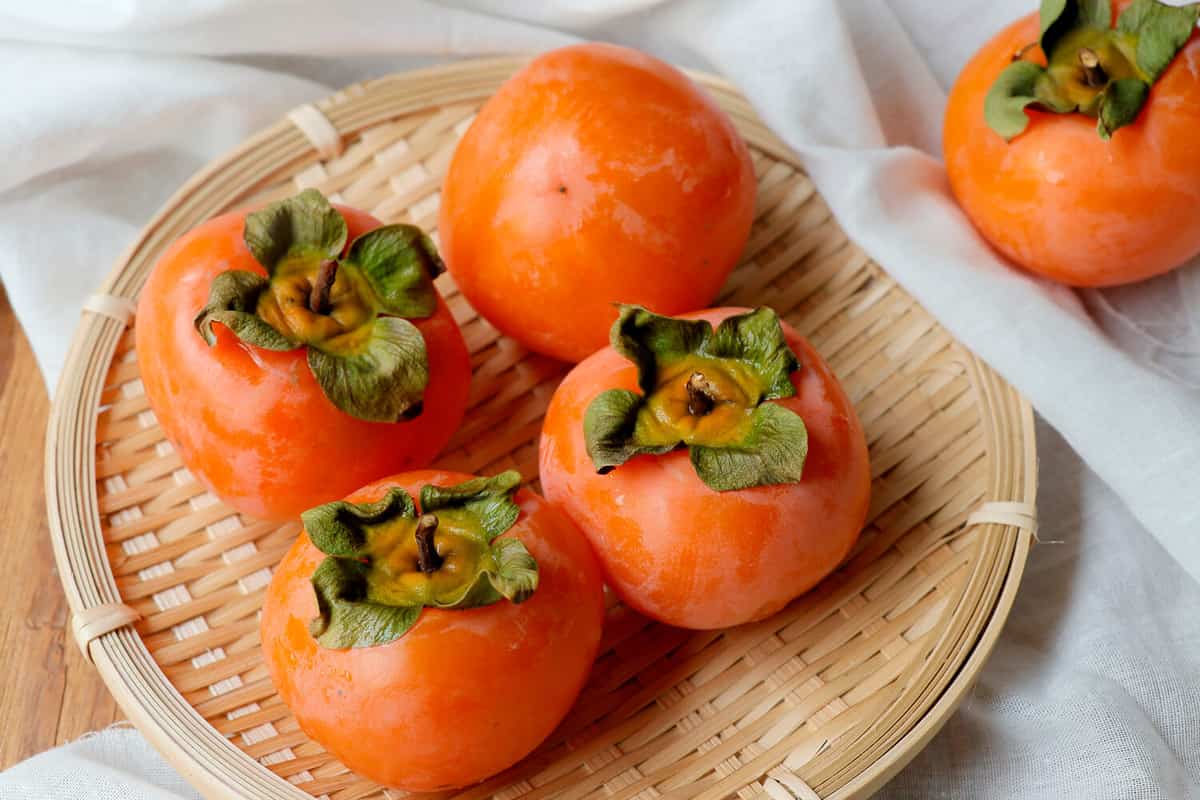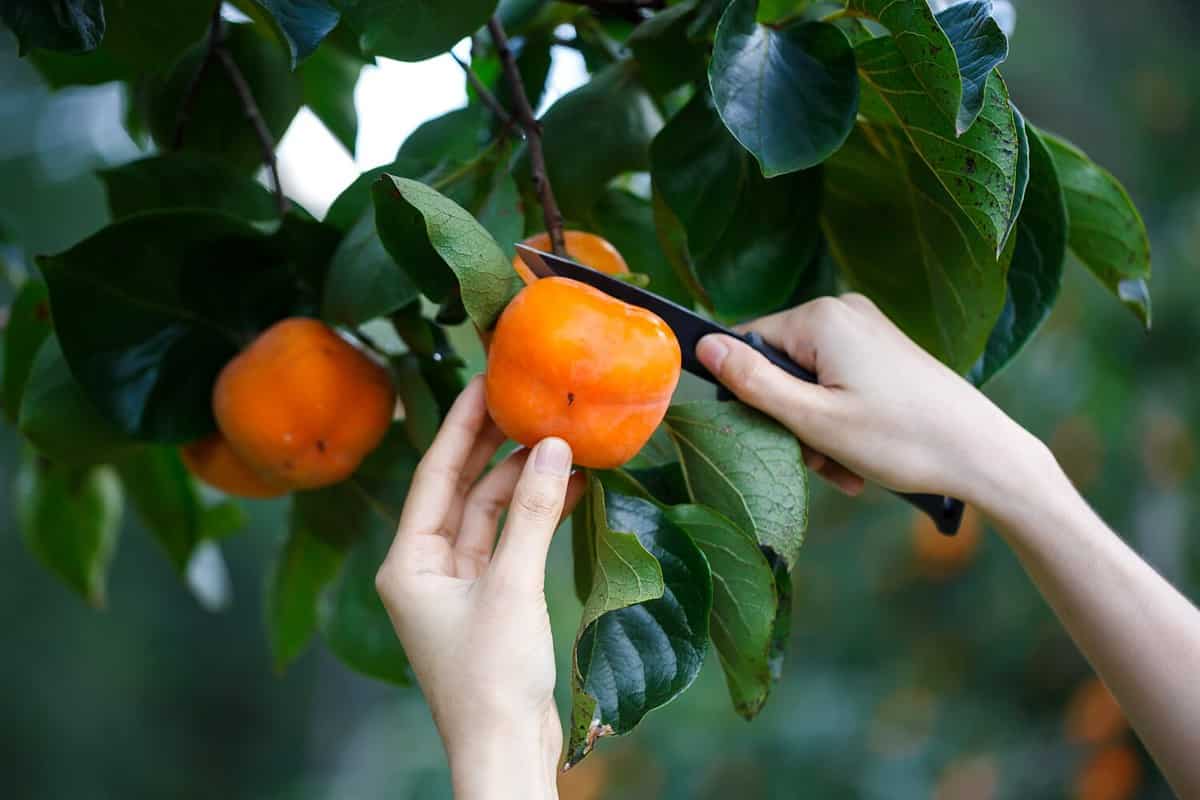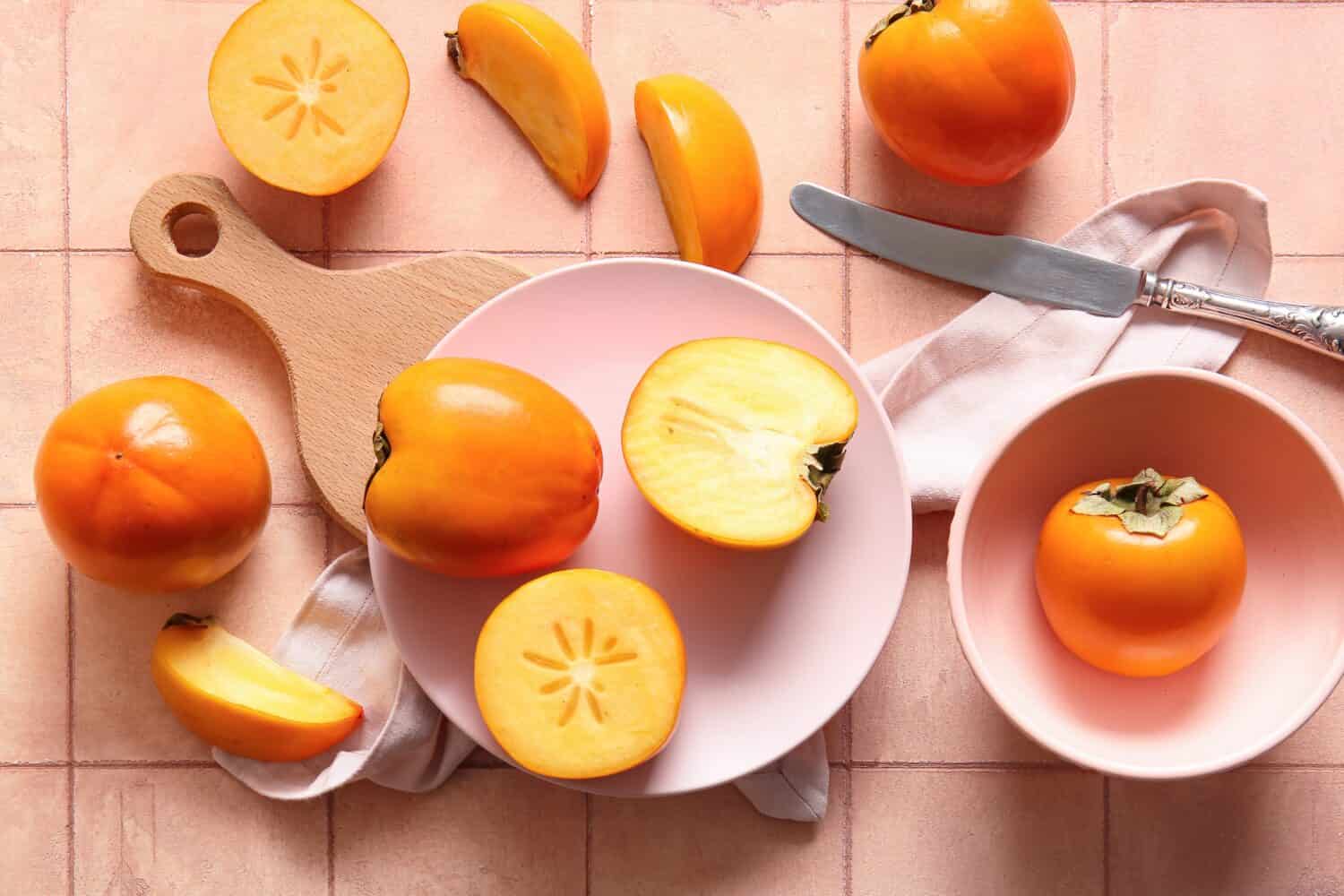Not all fruits are the same, although most fruits share one specific quality: their sweetness. If you’ve ever tried a persimmon, you’ll know that this fall fruit is about as sweet as they come. However, persimmons aren’t as common as fruits like apples and oranges, and you might not have seen a persimmon before.
A persimmon is a type of fruit that’s native to China. Although it is grown in the United States, primarily in California, it’s not as common as other types of fruit. This fruit is shaped like a tomato but is typically light yellow or orange on the outside.
If you’re a fan of sweet fruit and honey, you’ll love the unique taste of persimmons. Although they’re mainly grown in California, you can find them in other states as well. Keep reading to find out more about this delicious fall fruit.

Even though they look like a tomato from the outside, persimmons are a sweet fruit with a honey-like flavor.
©GWX/Shutterstock.com
What Is Persimmon Fruit?
Fruit can be a tasty snack, a healthy topping for waffles or yogurt, or even the base for a delicious smoothie. Although they’re delicious and sweet, fruit is generally full of nutrients and has numerous health benefits as well.
You won’t find them in all grocery stores, but persimmons are a delicious and sweet treat that can be beneficial for your health. One thing to know about persimmons is they’re a fall fruit, which means they’re typically in season between September and December.
There is more than one type of persimmon, and these types have many differences between them. Generally, you can eat persimmons like you would an apple since the peel on the outside is edible.
Types of Persimmons
When it comes to eating persimmons, it’s good to know that there are over 10 different varieties. However, not all varieties are common. In the United States, there are only two varieties that you’ll commonly see and those are fuyus and hachiyas. Here’s a look at the differences between the these two varieties:
- Hachiyas
Hachiya persimmons are one of the most common varieties. They generally have a bright orange peel and are shaped like an acorn. To enjoy the sweet flavor of a hachiya persimmon, don’t eat it until it’s soft and fully ripe. Otherwise, the flavor will be incredibly bitter. - Fuyus
Fuyus are another variety of persimmons that you’ll find in the United States. This type of persimmon is shaped more like a tomato, unlike the hachiya variety. You’re more likely to find this variety in Asian markets in the United States.
Fuyus are also bright orange on the inside and on the outside. Unlike the hachiyas, if you eat fuyus when they’re not completely ripe, they’ll still be sweet.
Despite there being so many types of persimmons, hachiyas and fuyus are the kinds you’ll most commonly find in grocery stores in the United States. If you want to find a wider variety of persimmons, check in your local Asian market.
How To Eat Persimmons
When you try a new fruit, one of the first questions that probably comes to mind is how do you eat it? Not all fruit is eaten the same way and it’s important to know whether it needs to be prepared, what parts you can eat, and if there’s anything you need to look out for.
Both of the common varieties of persimmon are relatively easy to eat since most parts of the persimmon are edible, including the peel. Once it’s ripe, you can easily wash and then slice the persimmon or you can bite into it directly like an apple.
What Do They Taste Like?
Even though most fruits are sweet, they can also each have complex and unique flavors. Persimmons generally have a sweet flavor, reminiscent of honey. The skin or peel of persimmons is edible although it is a bit tough–closer to a peach than an apple.
As with the most popular types of persimmons, don’t bite into it when it’s not ripe. If you do, you’ll experience a bitter and sour flavor instead of the normal sweetness. Especially if you’re purchasing hachiya persimmons, be sure they’re soft and ripe before you eat them.

No matter how you eat them, there are many health benefits to eating this fall fruit.
©nutt/Shutterstock.com
Benefits of Eating Persimmons
Most fruits aren’t just tasty treats–they also have a lot of health benefits. This is true of persimmons as well so you can enjoy this sweet, delicious fruit guilt-free. Here’s a look at some of the health benefits of eating this fall fruit:
Good Source of Vitamins
Persimmons, no matter how you eat them, are a great source of many vitamins and minerals. This is especially true when it comes to vitamin A, vitamin C, copper, and manganese. Just one persimmon can provide you with 26% of your daily value of manganese and 21% of your daily value of copper.
High Amount of Antioxidants
Antioxidants are an important part of your health, and persimmons are a great source of antioxidants. Consuming fruits and other food that have high amounts of antioxidants can benefit your health by decreasing your risk of certain chronic illnesses and boosting your immune system.
Good For Your Heart Health
Considering how many people each year are impacted by heart disease, taking care of your heart should be a top priority. The nutrients you get from eating persimmons are great for your heart. This is especially due to the flavonoids that can reduce your risk of certain heart conditions.
Nutritional Value of Persimmons
One serving of persimmons provides you with many nutritional benefits, but like many fruits, they do have quite a bit of sugar. Be sure to indulge in this tasty fruit in moderation, although it may be tempting to eat more than one.
One serving of persimmons includes:
- 118 calories
- 31 grams of carbs
- 1 gram of protein
- 6 grams of fiber
- 0.3 grams of fat
Keep in mind that there’s a lot of nutrients and minerals involved, so instead of just looking at the calories or sugar content, remember that you’re getting essential nutrients from the fruit as well.
Ways to Use Persimmons
Fruits like persimmons are a delicious and sweet treat on their own, but they’re also great for including in a variety of recipes. They’re the perfect complement to all your fall recipes! If you’ve found some ripe persimmons in the store and are looking for a way to use them, you can use persimmons to make:
- Fruit tarts
- Pie
- Salad
- Compote
There is no shortage of ways you can use persimmons in both sweet and savory dishes. One of the simplest and most delicious ways to enjoy persimmon as a tasty dessert is to freeze them to make a sort of custard.
To make this dessert, all you have to do is to freeze ripe persimmons for several hours or even overnight. Remove the persimmons at least 15 minutes before you plan on eating them. Then, use a serrated knife to cut off the top of the fruit and scoop out the inside like you would custard. It’s a simple dessert but absolutely delicious.
Final Thoughts
Whether you’ve tried a persimmon before or not, they’re a delicious and sweet fruit many people across the world enjoy. From their many health benefits to their sweet, honey-like flavor, there are plenty of things to love about persimmons.
While there are over 10 different varieties, there are two main ones that you’ll see in grocery stores in the United States. This fruit is in season between September and December, so keep an eye out for fresh persimmons in the fall.
The image featured at the top of this post is ©Pixel-Shot/Shutterstock.com
